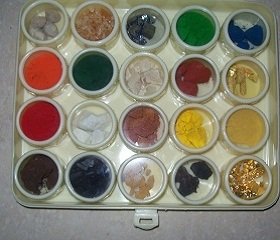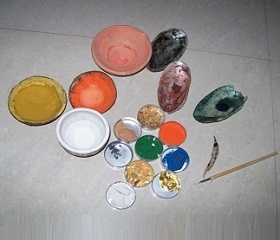Earth or Mineral Colours
Materials or Simply Colours available in the form of stones come under this category such as:
(a) White
(b) Black
(c) Shingraf
The white chalk, locally known as Khadia, is of two varieties: Phool Khadia and Kath Khadia. For the purpose of painting only Phool Khadia is used. Several Khadia mines are located at village Bansko, east of Jaipur (on the Jaipur-Agra road). In Bikaner region, Khadia found in Kolayat village is of superior quality.
In order to obtain this basic colour, a sand lamp is placed over the lighted lamp till a black soot or a lump black Kajal derives from the Khadia. Babul gum, Acacia resin and water are then added to this Kajal and grinded slowly between first fingers till it gets tempered to obtain fine black colour. Black ink is also prepared in Jaipur in the same manner. In earlier days writing black ink was prepared all over Rajasthan in the same way. The only difference between ink for writing and for painting is that the latter contains less gum in comparison with the first.
It is also known as Hansraj Hingalu. It is obtained in form of stones and it is heavy like mercury. It is of two varieties: Roomi and Katha. Needle like projections are visible in Roomi variety. For the purpose of painting it is preferable to use this variety of Shringarf, well mixed in sheep milk and with a generous add of lemon juice. The mixture is then filtered several times by putting it in water, till the portion of mercury rests deposited in the lower part, in order to avoid its use on the painting surface.


Additional Materials :
Basic miniature painting include preparation of colour by grinding them together with water and natural gum/tree’s gum for proper binding with paper, while the other half portion include surface on which colour is applied.
There are various surface used for painting viz. handmade paper, silk/cotton cloth, wooden plates. In all these surface paper is most common and convenient for miniature technique now for further process paper is proceed is background colouring. then a sketch on paper is made.
Further steps include colour implementation. then an outline of subject is made through fine miniature brushes. Now detailed work is done through miniature technique.